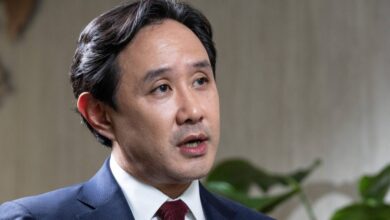Israeli fire wounded United Nations peacekeepers on the second day of attacks
Israeli forces wounded two United Nations soldiers on Friday, the second straight day peacekeepers were attacked as Israel continued its offensive against Hizbollah in southern Lebanon.
The attacks on Unifil forces deployed along the de facto border of Israel and Lebanon drew international condemnation and came 10 days after Israeli forces invaded the south of the country and stepped up attacks. military work.
US Defense Secretary Lloyd Austin called on Israel to ensure the safety of UN peacekeepers in a call with his Israeli counterpart Yoav Gallant. Austin said Israel should “shift direction” from military operations in the country to a diplomatic solution as soon as possible, according to a Defense Department statement on Friday.
The UN delegation described the fire at its location as a “serious development. . . These incidents in turn left United Nations peacekeepers serving in southern Lebanon at the request of the Security Council. . . There are very serious risks,” it said in a statement.
And the governments of France, Italy and Spain — all of which contribute personnel to Unifil — on Friday night condemned what they called “targeting” of peacekeepers.
“Those attacks are unjustified and will immediately cease,” they said in a joint statement issued through Rome.
“All peacekeepers must be protected and [we] reiterate our praise for the continued and indispensable commitment of the military/Unifil staff in this challenging context.”
The Lebanese army, which was not involved in the fighting, separately said two of its soldiers were killed Friday by Israeli airstrikes on a building near its checkpoint.
The Israel Defense Forces said a United Nations post was attacked after the Israeli military identified a “threat” 50 meters from the peacekeepers’ position. “The IDF is continuing to review the circumstances of the incident,” the statement said. Two United Nations peacekeepers were also injured by Israeli fire on Thursday.
It said it was investigating reports that several soldiers of the Lebanese Armed Forces were hit by gunfire as they carried out attacks on Hizbollah targets in southern Lebanon.
“The IDF emphasizes that it is not aware of any LAF facilities found in the area of the attack,” it said in a statement on Friday night.
The attacks in the south of the country came a day after Israeli airstrikes killed at least 22 people in central Beirut, raising fears that Israel’s pursuit of Hizbollah is expanding deeper into Lebanese capital.
Thursday night’s attack occurred more than 5km from the southern suburbs, which have been the focus of Israel’s stepped-up offensive against the Lebanon-based militant movement. This is the second time Israeli forces have attacked central Beirut in less than two weeks.
Lebanon’s interim Prime Minister Najib Mikati described the attack as “completely unacceptable” as he reiterated his call for a ceasefire. He said at least 139 people were injured in the attack. Mikati also condemned the deaths of two Lebanese soldiers in the south.
The attacks on the center of the capital exacerbated the sense of fear in the capital as Israeli drones buzzed overhead and warplanes broke the sound barrier. The city is filled with people fleeing intense fighting that continues in southern Lebanon.
One of the airstrikes targeted a residential building not far from the Lebanese national museum, in an area filled with small shops and apartment complexes. A family of eight, including three children, were killed in the bombing, said a relative who spoke on condition of anonymity. Israel did not say who it was targeting.
“We are all from southern Lebanon and have been displaced here in recent weeks due to Israeli aggression,” the relative told the Financial Times. “I don’t understand why they target us. These are just families.”
Lebanese are increasingly fearful that Israel is expanding its targeting by striking areas like those attacked on Thursday that have no known Hizbollah presence.
In the ruined Burj Abi Haidar neighborhood, site of another Israeli attack, rescue workers were still searching for bodies on Friday, sifting through the rubble of what residents said was at least Three buildings collapsed.

“A lot of families around here are poor and unrelated,” said Abu Ahmad, who lives in a building near the attack site. His grandfather’s apartment was in one of the collapsed buildings.
The IDF did not issue any warnings to residents before Thursday’s strike.
Israel says it is fighting the Iran-backed militant group to push its fighters from its border and prevent it from firing rockets into northern Israel, which has displaced 60,000 Israelis.
Hizbollah said its attacks on Israel, which began a year ago, were aimed at supporting Hamas, the militant group also linked to Iran that controls Gaza and that the October 7 attack on Israel caused war.
After nearly a year of cross-border shooting, Israel assassinated Hizbollah leader Hassan Nasrallah last month and stepped up airstrikes across Lebanon.
Speaking after assessing the situation with Israel’s Shin Bet internal security agency in southern Lebanon, the head of the Israeli army, Herzi Halevi, pledged that fighting would continue “until we ensure that we can bring people back safely.”
“If anyone considers rebuilding these villages again, they will know that building terrorist infrastructure is not worth it because the IDF will neutralize them again,” he said.
The war is having a punitive effect on civilians. Lebanese authorities say 1.2 million people have been forced to flee their homes and more than 2,000 have died, most in the past two weeks.
On Friday, the United Nations agency UNRWA said most Palestinian refugees living in camps in southern Lebanon or near Beirut had fled as a result of the bombardment, drawing parallels with mass displacement in Gaza.
Additional reporting by Steff Chávez in Washington; Cartography by Steven Bernard






